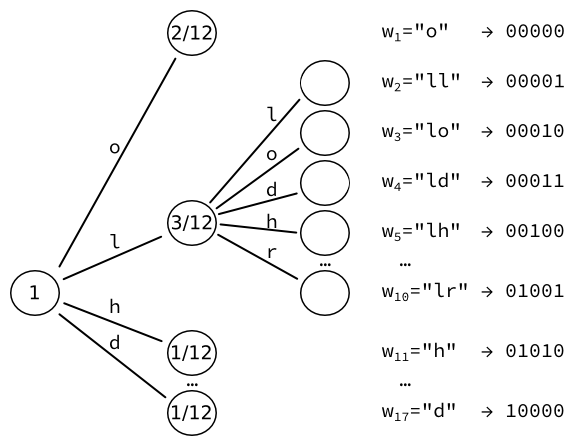Tunstall coding on:
[Wikipedia]
[Google]
[Amazon]
In
Study of Tunstall's algorithm from EPFL's Information Theory department that, for a large enough dictionary, the number of bits per source letter can be arbitrarily close to , the
 We then take the leaf of highest probability (here, ), and convert it to yet another tree of leaves, one for each character.
We re-compute the probabilities of those leaves. For instance, the sequence of two letters L happens once.
Given that there are three occurrences of letters followed by an L, the resulting probability is .
We obtain 17 words, which can each be encoded into a fixed-sized output of bits.
We then take the leaf of highest probability (here, ), and convert it to yet another tree of leaves, one for each character.
We re-compute the probabilities of those leaves. For instance, the sequence of two letters L happens once.
Given that there are three occurrences of letters followed by an L, the resulting probability is .
We obtain 17 words, which can each be encoded into a fixed-sized output of bits.
 Note that we could iterate further, increasing the number of words by every time.
Note that we could iterate further, increasing the number of words by every time.
computer science
Computer science is the study of computation, automation, and information. Computer science spans theoretical disciplines (such as algorithms, theory of computation, information theory, and automation) to Applied science, practical discipli ...
and information theory
Information theory is the scientific study of the quantification, storage, and communication of information. The field was originally established by the works of Harry Nyquist and Ralph Hartley, in the 1920s, and Claude Shannon in the 1940s. ...
, Tunstall coding is a form of entropy coding used for lossless data compression.
History
Tunstall coding was the subject of Brian Parker Tunstall's PhD thesis in 1967, while at Georgia Institute of Technology. The subject of that thesis was "Synthesis of noiseless compression codes" Its design is a precursor to Lempel–Ziv.Properties
Unlikevariable-length code
In coding theory a variable-length code is a code which maps source symbols to a ''variable'' number of bits.
Variable-length codes can allow sources to be compressed and decompressed with ''zero'' error ( lossless data compression) and still b ...
s, which include Huffman and Lempel–Ziv coding,
Tunstall coding is a code
In communications and information processing, code is a system of rules to convert information—such as a letter, word, sound, image, or gesture—into another form, sometimes shortened or secret, for communication through a communicati ...
which maps source symbols to a fixed number of bits.
Both Tunstall codes and Lempel–Ziv codes represent variable-length words by fixed-length codes.
Unlike typical set encoding, Tunstall coding parses a stochastic source with codewords of variable length.
It can be shownStudy of Tunstall's algorithm from EPFL's Information Theory department that, for a large enough dictionary, the number of bits per source letter can be arbitrarily close to , the
entropy
Entropy is a scientific concept, as well as a measurable physical property, that is most commonly associated with a state of disorder, randomness, or uncertainty. The term and the concept are used in diverse fields, from classical thermodyna ...
of the source.
Algorithm
The algorithm requires as input an input alphabet , along with a distribution of probabilities for each word input. It also requires an arbitrary constant , which is an upper bound to the size of the dictionary that it will compute. The dictionary in question, , is constructed as a tree of probabilities, in which each edge is associated to a letter from the input alphabet. The algorithm goes like this: D := tree of leaves, one for each letter in . While : Convert most probable leaf to tree with leaves.Example
Let's imagine that we wish to encode the string "hello, world". Let's further assume (somewhat unrealistically) that the input alphabet contains only characters from the string "hello, world" — that is, 'h', 'e', 'l', ',', ' ', 'w', 'o', 'r', 'd'. We can therefore compute the probability of each character based on its statistical appearance in the input string. For instance, the letter L appears thrice in a string of 12 characters: its probability is . We initialize the tree, starting with a tree of leaves. Each word is therefore directly associated to a letter of the alphabet. The 9 words that we thus obtain can be encoded into a fixed-sized output of bits. We then take the leaf of highest probability (here, ), and convert it to yet another tree of leaves, one for each character.
We re-compute the probabilities of those leaves. For instance, the sequence of two letters L happens once.
Given that there are three occurrences of letters followed by an L, the resulting probability is .
We obtain 17 words, which can each be encoded into a fixed-sized output of bits.
We then take the leaf of highest probability (here, ), and convert it to yet another tree of leaves, one for each character.
We re-compute the probabilities of those leaves. For instance, the sequence of two letters L happens once.
Given that there are three occurrences of letters followed by an L, the resulting probability is .
We obtain 17 words, which can each be encoded into a fixed-sized output of bits.
 Note that we could iterate further, increasing the number of words by every time.
Note that we could iterate further, increasing the number of words by every time.
Limitations
Tunstall coding requires the algorithm to know, prior to the parsing operation, what the distribution of probabilities for each letter of the alphabet is. This issue is shared withHuffman coding
In computer science and information theory, a Huffman code is a particular type of optimal prefix code that is commonly used for lossless data compression. The process of finding or using such a code proceeds by means of Huffman coding, an algo ...
.
Its requiring a fixed-length block output makes it lesser than Lempel–Ziv, which has a similar dictionary-based design, but with a variable-sized block output.
References
{{Compression methods Lossless compression algorithms